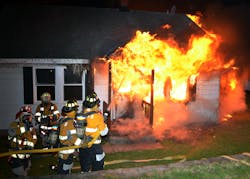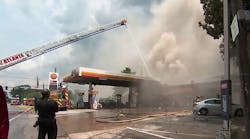Open any fire trade magazine or scan any firefighter website, and you will be inundated with new tactical options, scientific research and data from around the world. Research from UL, the National Institute Standards Testing (NIST) and Kill The Flashover (KTF) provides the fire service with an abundance of scientific data—much of which can feel overwhelming for a department with limited staffing.
The reduction in staffing and budgets has greatly affected both training and fireground operations. How do organizations implement all of the available research into the fireground training and operations? How do we support all the new tactical options with limited staffing?
Recognizing staffing limitations, applying the science (and adjusting technology choices accordingly), creating tactical playbooks, and maximizing water are all critical components for minimally staffed departments to operate effectively and safely on the fireground. Let’s consider each.
Recognize staffing limits
Staffing is a critical component in fireground tactical decision-making. The first step is recognizing that smaller organizations cannot operate like large departments. If an organization responds to a working structure fire with a 3-1 assignment or less, they are considered limited staffed. Regardless of whether you’re volunteer, combination or career, the simple fact is that three engines and one ladder provide an average of 12 firefighters, which limits the tactics that can be performed at any given moment.
Larger organizations can provide a greater number of resources and therefore conduct simultaneous tactical operations. Quick response times and availability of water supply also aid larger departments in catching fires while they are small. The large departments are all great organizations and provide valuable lessons learned for all of us; however, small organizations must recognize they are different purely due to size.
For many smaller organizations, it becomes an emotional struggle—they want to be like FDNY, Chicago, Phoenix and other high-profile organizations, but simply cannot. In many cases, smaller department firefighters try to emulate larger organizations by attempting to operate and train like the “big boys,” so much so that they even try to dress and act like them. This creates a false identity in both the firefighters and the organization, which is very dangerous, operationally and culturally.
We must recognize the limitations associated with limited staffing and adjust our tactics accordingly. This does not mean small departments are less aggressive or defensive fire departments; it just means that they must maximize the resources brought to the scene using technology, science and proficiency.
Apply the science
Modern fire dynamics and building construction research and data greatly impact limited staffing and rural departments by providing new tactical options that can be conducted with limited staffing. The data has disproven many of the myths of the fire service, such as exterior hose steams will push fire, vent for life, don’t flow water until you reach the seat of the fire, don’t direct hose streams into the super-heated gasses, to name a few.
Interestingly, many of these fire service myths were disproven years ago by fire departments from around the world. In the 1990s, the Swedish fire service began adjusting their tactics to fit the fire dynamics that they were encountering. Other European fire departments and Australian departments soon followed suit and adjusted their tactics based on their own research. Now it is our turn.
The first step is actually to step back and put aside our own beliefs and take an open-minded approach to the data. For many of us, the data contradicts what we were taught. I recommend creating a committee to address the science. To strengthen your committee, I suggest including a wide variety of experience, from the rookie to the senior member. The diversity in the committee will help create ownership among your firefighters.
Secondly, to help small departments best accept and utilize the research, test the science data either by conducting training opportunities or facilitating the opportunities for your firefighters to attend research burns.
Finally, become the expert! Study the data, understand it, challenge it and then accept it, making sure you use valid sources for your data. UL, NIST and KTF are all documented sources. UL has an excellent online training program that provides free training.
Creating a culture of evolution, education and evaluation is essential. I tell our firefighters that we will continue to evolve as research is produced—and our tactics and technology will adjust, too. Tactics and technologies such as transitional attack (quick water), tactical TIC, smoke curtain, fognail and others are providing smaller organizations with more tactical options that require less staffing and less water.
Create tactical playbooks
One of the challenges with smaller organizations is creating consistency in training that equals proficiency on the fireground. Coaches create an offensive and defensive playbook during practice to use during the game. The coach selects the proper play based on conditions of the game, time, position, score, etc. Creating a playbook for the fireground provides consistency in training and gives the incident commander the opportunity to select the proper play based on fireground conditions, staffing, resources, water supply, time, location of the fire, etc. For smaller departments, creating offensive tactical plays that match their staffing and resources is critical. By creating the play, it becomes a documented sequence of skills that improve proficiency on the fireground. The playbook allows the firefighter to have a thorough understanding of their role, and represses the adrenaline during the incident. Modern research provides four new tactics (plays) that are beneficial for minimally staffed departments and rural departments.
Transitional attack: Transitional attack consists of quick water from an exterior position immediately followed by an aggressive interior attack to finish extinguishment. This is a huge paradigm change for the fire service. For the last 30 years, we have been taught to never flow water from the outside unless in defensive conditions for fear we would “push” the fire. The science proves that we don’t in fact “push” fire. Attacking the fire at its visible location from the outside is critical, and the faster we can apply water, the better. This means we need an aggressive 360 of the structure to identify the fire’s location. Our habits lead us to attack from the front door. We must re-train ourselves when possible (advantageous and appropriate) to attack the fire from the visible. The use of tactical TIC can aid in identifying the location for attack. Having the knowledge and ability to identify the intake (air source) and exhaust or fuel-limited or vent-limited conditions aid in determining if transitional attack will be an effective play. Transitional attack allows time for additional resources to arrive and is effective in maximizing the limited water and staffing on initial response. The big question is what about the rescue? With limiting staffing and limited resources, in many cases, attacking the fire first might be the best option.
Laramie County, WY, Fire District #2 created a training play called “minute thirty drill,” which consists of one engine company arriving on scene, deploying and charging a handline in full PPE within 1 minute and 30 seconds from the time the airbrakes are set. Being proficient in these basic skills makes a huge impact on the fire. I caution all organizations that there are many factors that determine whether to go for the rescue or extinguishment first. Don’t limit your decision-making to always or never. It all depends on the situation.
Smoke curtains or barriers: Research supports closing the door, which limits the oxygen and slows the growth of the fire. This tactic requires leaving a firefighter at the door to control the door and provide assistance with hose management. For the larger departments, this can be accomplished with their existing staffing. This is almost impossible for minimally staffing departments or rural departments. However, there are opportunities for the small departments to tactically control the door. The first item is to recognize the need to close the door whenever possible. If you arrive on scene as a single resource, aggressively secure all doors. DO NOT sit at the front of the structure with the front door wide open. Close the door. It buys time, allowing you to get set up for tactical operations.
Secondly, deploy a smoke curtain. Dr. Michael Reich, a German chief officer, developed the Smoke BlockAid, which is a portable curtain that is deployed in the doorway to control the flow path. The deployment of the curtain controls the flow path and is designed to allow for easy advancement of hoselines under the curtain. The curtain is easily removed or breached in case of bailout. The use of the smoke curtain frees up the door control firefighter, maximizing the on-scene staffing—a huge benefit for smaller organizations. The Smoke curtain can also be used on the interior of the structure to secure stairways and compartmentalize larger structures.
Maximize water
Over the years, there has been a huge debate over fog nozzles versus smoothbore nozzles and, truthfully, they both have their advantages and disadvantages. For smaller organizations, the challenge on nozzle selection is compounded by the lack of staffing and water supply. How does a rural fire department maximize the effectiveness of the limited water it has on scene? In an urban environment with a hydrant on every corner, flowing a 2.5-inch smooth bore can be very effective, but is it effective for small limited staff departments?
Some can argue that hitting it hard with big hose is your best option. In my opinion, it all depends; lots of variables are included in that decision. The alternative to overpowering the fire with gpm is to understand the science of thermal ballast through steam conversion and effective hose stream placement.
Water running out the front door into the street is not effective use of water, and in the rural setting, it is not realistic. There are two principles that smaller departments and rural department should implement and become proficient with: gas cooling and surface cooling. The use of proper nozzle technique to cool the super-heated gases through water droplet and steam conversion provides thermal ballast in the smoke. This limits the flashover potential and slows the fire’s progression even before reaching the seat of the fire. Good gas cooling technique takes practice, so take the time to learn the proper operation of your tools (fog or smoothbore).
The opposite of gas cooling is surface cooling. Stopping or slowing pyrolysis by cooling the surfaces is a critical component in reducing flashover and slowing the fire’s progression.
One of the challenges with today’s fire service is our inability to teach good nozzle techniques in real conditions. With the restraints of concrete or steel training props, and the requirements of NFPA 1403, we limited teaching opportunities. In fact, we teach young firefighters to not flow water in training because it ruins or hinders the next evolution. Further, our firefighters aren’t experiencing as many fires as in years past. This goes back to training and understanding the limitations of our tools. Training in conjunction with understanding the science then applying it makes a difference.
The final operational tool that is important for limited water supply organizations is a German tool called the fognail. The fognail is a piercing nozzle that can be deployed and left, maximizing staffing. Many departments throughout the U.S. purchased piercing nozzles, and they’ve sat on the apparatus never to be used or seen again. The fognail is equivalent to placing a sprinkler head into the structure or compartment. It produces a very fine water droplet or mist that coverts rapidly to form steam. That steam creates thermal ballast which inerts the super-heated gases, preventing fire growth. We have all been taught to fear steam, but when used properly, steam is a very valuable tool for us. KTF has done numerous tests on the benefits of using small water droplet and steam conversion in suppression, and the results have been overwhelmingly successful. Last month we deployed two fognails in a 2,800-square-foot home with common attic. The occupancy had a continuous attic with heavy fire. We deployed two fognails, one through the pitched roof the other from the gable end (20-40 gpm). Because of the small droplet and rapid conversion to steam, we maximized our water supply and successfully saved the balance of the house. The home suffered very little water damage and property conservation was very successful.
In sum
Rural fire districts and limited staffed departments have unique challenges, lack of water supply, lack of resources and long response times. These factors can be overcome by applying the science and creating training that increases proficiency and effectiveness of fireground skills.






